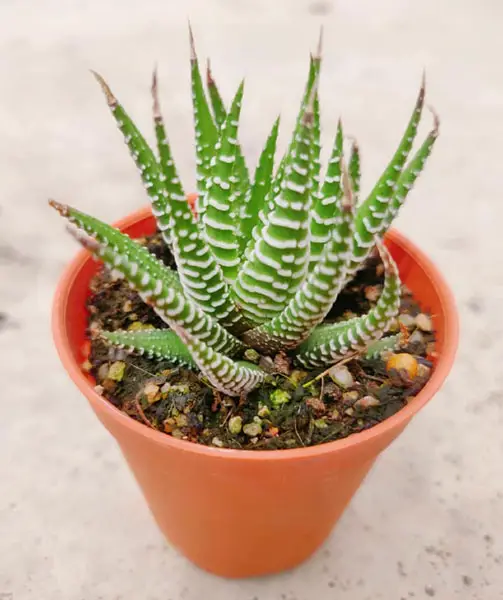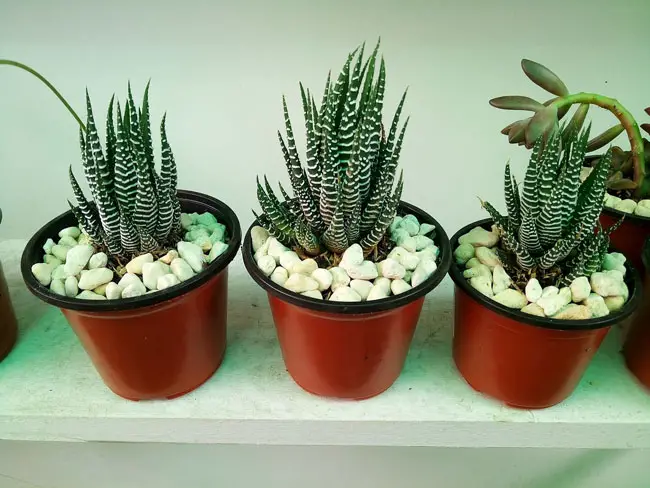Taking care of succulents has become a widespread hobby among plant enthusiasts today because they look great in any garden or home and how comparatively easy they are to grow and take care of.
If you want to add a good succulent to your collection, the Haworthiopsis Fasciata(also known as Zebra Plant or Zebra Haworthia) would be a nice choice because it is actually a good houseplant that won’t require a lot of care and attention on your part. So, how do you care for a Haworthiopsis Fasciata?
The Haworthiopsis Fasciata, previously the Haworthia fasciata, is an easy plant to take care of. It primarily needs to be left under indirect sunlight and will only need to be watered once every two to three weeks or when the soil is already dry. You don’t even need to put a lot of effort into this plant to take care of it.
You will be delighted to know that you don’t need to be a plant expert to care for the Haworthiopsis Fasciata or the zebra plant properly. However, that doesn’t mean that you shouldn’t learn how to take care of it.
There are still some things that beginners should know more about this plant, especially if you want to make sure that it gets to enjoy a long life and that it grows up to be a suitable decorative succulent for your house or garden.
Location And Climate Requirements
It is commonly believed that Haworthiopsis fasciata, a succulent species from South Africa, thrives in dry climates and requires little water. While this may be true for mature plants, it is important to note the conditions of their native habitat when caring for younger specimens. In its natural environment, H. fasciata grows in shady spots with access to ample amounts of moisture during the wet season. As such, it’s best to mimic these conditions as much as possible when growing young plants indoors or outdoors.
When planting outside, make sure the area has good drainage so excess water can escape quickly after rain or watering sessions. If you live in an arid climate and don’t have enough shade available naturally, consider providing some artificial protection by building a trellis or putting up a sunshade cloth over your plant bed. Indoors, keep away from direct sunlight and mist regularly instead of pouring too much water directly onto the soil surface.
Light Requirements
The Haworthiopsis fasciata thrives in bright, indirect light and requires at least 4-5 hours of direct sunlight each day. It is important to ensure that the plant does not receive too much sun as this will cause fading or browning of its leaves. Here are some key points to consider when providing adequate lighting for your Haworthiopsis fasciata:
- Place the plant near a window that receives plenty of natural light throughout the day.
- Avoid placing it next to air conditioners or heat sources, as these could create an unstable environment for the plant.
- If you live in a colder climate, position lights above the plant so they don’t get too cold during winter months.
- Make sure there is a gap between plants and any other objects in order to prevent overheating from reflective surfaces like glass windows or mirrors.
Water And Soil Needs
Haworthiopsis fasciata is a thirsty plant. It’s almost as if its roots have an unquenchable desire for water. This succulent requires frequent but light watering. In fact, it must be watered so often that some people might think this species of Haworthia was born to thrive in rainforest-like conditions.
To ensure the best care for your Haworthiopsis fasciata, use well-draining soil with organic matter and sand or gravel incorporated into it. The ideal pH level should be between 6.0 – 7.5 to ensure proper nutrient uptake from the soil.
If you find that your plant’s leaves are turning yellow or brown at the tips, then you may need to increase the amount of fertilizer being used. Additionally, make sure not to leave any standing water around the root system; this could lead to rotting and eventual death of your beloved Haworthiopsis fasciata.
Fertilizing Guidelines
Fertilizing Haworthiopsis fasciata is essential for optimal health. However, it’s important to avoid over-fertilization because this can cause leaf burn and damage to the plant. The best way to fertilize your haworthiopsis fasciata is with a balanced fertilizer that contains equal amounts of nitrogen, phosphorus, and potassium in an NPK ratio of 10:10:10.
For established plants, use a quarter-strength dose every two weeks during spring and summer when growth is most active. During winter months, reduce the frequency to once per month or skip entirely if temperatures are cooler than normal. When applying fertilizer, be sure not to get any on the leaves as they may become burned by direct contact with the nutrients.
When it comes to foliar feeding, dilute liquid fertilizer into the water according to instructions on the packaging and spray onto foliage lightly twice monthly during the growing season only. This helps ensure adequate nutrition without risking root burn from strong concentrations of chemicals near the roots.
Potting And Transplanting Procedures
Potting and transplanting Haworthiopsis fasciata is a relatively simple process. The soil should be well-draining, with some organic matter mixed in to retain moisture. It’s important not to overwater this species of succulent; they do best when the soil has been allowed to dry out completely between watering sessions.
When it comes time for repotting or transplanting, choose a pot one size larger than before and fill it with fresh soil mix. Gently remove the plant from its current container and shake off any excess dirt. Place the new pot on a stable surface, making sure that drainage holes are lined up properly at the bottom.
Carefully place the plant into the new pot and lightly press down around it so that it fits snugly inside – be careful not to press too hard as you could damage the roots.
Pruning And Trimming Tips
Caring for Haworthiopsis Fasciata is truly a joyous experience. After successfully potting and transplanting your succulent, it is time to get down to the nitty-gritty details of pruning and trimming. Pruning this beautiful plant can seem like an intimidating task at first, but once you understand how it works, it will become second nature.
Firstly, Haworthiopsis Fasciata should be pruned with clean shears or scissors. It’s important to keep these tools sterile in order to avoid introducing any bacteria into the plant environment. You’ll want to pay special attention when pruning off any dead or damaged leaves as they may contain disease or pests that could spread across your entire collection if left unchecked. The best way to make sure all unhealthy parts are removed is by using sharp instruments so you don’t accidentally damage healthy tissue while cutting away the bad stuff.
For those looking for more precision when trimming their plants, there is also the option of using tweezers instead of regular scissors for a finer cut on small branches and leaves. Additionally, always wear gloves when handling Haworthiopsis Fasciata as its sap can irritate skin upon contact. Believe me – you won’t regret taking extra care during this process.
Troubleshooting Common Problems
Haworthiopsis fasciata is a rugged succulent that can handle many of its own problems. However, there are still some common issues you may encounter when caring for your plant.
The first issue to watch out for is too much water or not enough water. Haworthiopsis fasciata does best with regular, but minimal, watering and should be allowed to dry out between each session. Overwatering will cause root rot and lead to the death of the plant. Underwatering can also be an issue because it leaves the plant susceptible to pests and diseases like mealybugs and fungal infections. If this happens, remove affected areas as soon as possible before they spread further.
Another problem that arises with Haworthiopsis fasciata is sunburn or frost damage which can occur if the plants are exposed to direct sunlight or cold temperatures respectively. To prevent this from happening, make sure the plant has adequate shade during hot days and keep it away from cold drafts in winter months. Additionally, use a light fertilizer at least once every couple of months to provide essential nutrients for healthy growth.
Insect Management Tactics
Insect pests can be a common problem for Haworthiopsis fasciata. The most effective way to manage these insects is through prevention, as many of them are nearly impossible to eradicate once they have become established in the plant. To prevent insect infestations, it’s important to inspect plants regularly and take action when you spot any potential problems. This could include removing dead leaves or pruning off affected foliage.
It’s also important to keep your Haworthiopsis fasciata away from other plants that may harbor insects, such as older specimens of cacti or succulents. Additionally, avoid overwatering and make sure not to put too much fertilizer on the soil — both of these practices can attract undesired bugs into your garden. If you do find yourself dealing with an infestation, there are several safe pesticides available which can help get rid of the pests quickly and effectively without harming your precious houseplant.
Once you’ve taken steps to protect against future damage, provide regular maintenance by wiping off dust particles and inspecting for signs of new pest activity at least one time per month.
Disease Prevention Measures
Now that we’ve discussed ways to protect Haworthiopsis fasciata from insect infestation, let’s talk about how to keep the plant healthy and prevent diseases. Healthy soil is essential for a thriving Haworthiopsis fasciata. The soil should be well-draining with some organic matter like compost or peat moss mixed in. To maintain moisture levels it’s important to water regularly and thoroughly but avoid letting the pot sit in standing water as this can lead to root rot.
Fertilizing once every two weeks during the growing season will also help to ensure your Haworthiopsis fasciata stays healthy. This succulent prefers liquid fertilizer diluted at half strength rather than granular fertilizers which could burn its delicate leaves. Additionally, it’s important to make sure you are not over-watering or under-watering this plant as either too much or too little moisture can cause leaf discoloration or drop off of foliage.
Here are 4 key points for disease prevention:
- Provide nutrient-rich soil; mix in organic materials such as compost or peat moss.
- Water regularly, avoid overwatering, allowing the soil to dry between sessions.
- Fertilize lightly using diluted liquid fertilizers every 2 weeks during the active growth period.
- Avoid drastic changes in temperature and humidity * Prune regularly to promote healthy growth and remove dead or damaged branches.
How Do You Propagate Haworthiopsis Fasciata?
The Haworthiopsis Fasciata is actually pretty easy to propagate in case you want to add more zebra plants to your garden or house or in case you are looking to make sure that your mother plant gets to live another life in its children after the original plant has already lived past its lifespan.
In most cases, propagating this type of plant should be quite similar to propagating other types or variants of succulents. There won’t be many differences as the zebra plant is quite an easy specimen to propagate.
So, if you want to propagate the plant, you can follow these steps:
- Take a cutting from the mother plant using clean and sharp scissors or garden shears to make sure that the cutting is removed as smoothly as possible. You can choose between a leaf or a stem so long as either of them is healthy enough. The zebra plant also produces offsets, which you can use to propagate the Haworthiopsis Fasciata.
- If you use cuttings instead of offsets, allow the freshly cut leaf or stem to heal its wound first by leaving it somewhere to dry for a few days. Allowing the wound to heal is vital before planting the new succulent. When the wound has already dried up and the leaf or stem is still in great shape, that is when you will know that it is ready to be planted to propagate a new plant.
- Plant the cuttings in their own individual pot. You can do this immediately if you use offsets, but you need to wait for their wounds to heal if you use cuttings as your preferred propagation method. If you are using offsets, you can cut them off of the mother plant without waiting for a long time for them to heal and dry up.
- Make sure that the soil in the pot is moist but not too wet. Do not overwater the plant because this could lead to molds, fungi, and other health problems. Only water it when the soil is about 70% dry, and make sure that you only water until the soil is moist. But when the cutting or offset has already grown into its own plant, follow the usual watering procedures for watering a Haworthiopsis fasciata.
How Often Do You Water A Haworthia?
Like any plant or organism on earth, Haworthiopsis fasciata needs water to survive even though it is a succulent native to South Africa, which doesn’t have the same moisture and abundance of water that some other regions have.
Thriving in places that are hot, dry, and lacking in water was what made succulents such as the zebra plant capable of surviving without the need to drink a ton of water. However, this plant still needs to be watered from time to time.
So, how often do you water the Haworthiopsis fasciata?
First of all, like most succulents, you need to place the Haworthiopsis fasciata in a well-drained pot with drainage holes that are quite big so that you can allow the water from the soil to pass through them efficiently. You water the plant directly on the soil so that the zebra plant’s roots can easily access the water.
When you water the Haworthiopsis fasciata, ensure that you do so until the water starts draining from the soil through the drainage holes. As soon as that happens, immediately stop because that is when you will know that the soil is already moist enough. Do not overwater the soil because this can lead to many problems such as molds, fungi, and other illnesses.
It will take a while before the soil once again needs to be rewatered. In some cases, you need to wait until perhaps two to three weeks before you need to water the plant once again. Of course, the rule of thumb to follow is to ensure that the soil is completely dry before watering it again. So, if the soil dries out in about a week, you need to water it again without waiting for two to three weeks.
Whenever it’s summer, you may need to water the zebra plant more often than you would because of how the hot weather will easily evaporate the moisture out of the soil to dry it out. Again, the rule of thumb to follow is to ensure that the soil is completely dry before watering it again. And whenever it’s summer, make sure that you thoroughly water the Haworthiopsis fasciata soil without overwatering.
Also, it is important to know that you need to lessen the frequency of watering your Haworthiopsis fasciata as the temperatures grow colder and colder. During the winter, you may even have to wait for more than three weeks for the soil to completely dry out as cold weather won’t evaporate the moisture from the soil just as quickly as the summer heat does.
Does Haworthia Need Sunlight?
Like most succulents, the zebra plant desperately needs a lot of sunlight as it relies almost entirely on the sun for its energy. In that sense, you need to keep it exposed to sunlight as long as you can because of how the Haworthiopsis fasciata is a full-sun plant.
But the one thing you need to remember here is that the zebra plant doesn’t do well when exposed to direct sunlight, especially if you live in a particularly hot region. That’s why it is most often considered a houseplant that you should keep indoors but close enough to the windows so that it can get exposed to indirect sunlight all day long.
However, if you do live in a region that isn’t particularly warm, such as when you live up north, you may be able to keep the Haworthiopsis fasciata outdoors as long as the sun isn’t too harsh, the zebra plant can withstand moderate sunlight, but it should not be exposed to the heat of the summer sun even though, in some cases, it can still tolerate high heat levels. It is still better to keep it away from direct sunlight and store it indoors as a houseplant.
How Do You Get Haworthia To Flower?
One of the best features of the Haworthiopsis fasciata is that it is a flowering succulent that produces great-looking flowers that are nice to look at regardless of wherever you may be keeping the plant. However, if you are keeping it outdoors, zebra plants bundled together will produce an amazing sight, especially because they have white or pinkish flowers captivating to the senses.
For Haworthiopsis fasciata grown indoors, you can expect them to flower during the spring or the summer naturally. You don’t need to force them or induce them into flowering because this plant will flower or bloom naturally on its own, depending on the season or the time of the year.
However, for those keeping it indoors, you have to understand that you won’t get the full bloom of this plant because it doesn’t get the same sunlight that it would if you had kept it outdoors.
Meanwhile, if you keep the Haworthiopsis fasciata outdoors, you can expect it to bloom sometime during spring or summer as well. However, there are cases where an outdoor zebra plant will flower during the fall. A zebra plant grown outdoors can produce a full bloom and may even grow long stems whenever it is flowering.
So, for those intending to keep zebra plants for their flowers as decorative pieces for a garden, it might be best to keep them outdoors to get to bloom compared to when you keep the plants indoors fully.
But you have to make sure that the outdoor climate in your region is suitable for the Haworthiopsis fasciata, or else it might end up developing health problems if the climate is too cold or too hot for it.
Did you find this post useful? Would you like to get back to it later? Save THIS PIN below to your house plant and succulents/cactus boards on Pinterest! Thanks 🙂




